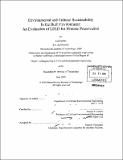| dc.contributor.advisor | Jerome J. Connor. | en_US |
| dc.contributor.author | Ferriss, Lori (Lori E.) | en_US |
| dc.contributor.other | Massachusetts Institute of Technology. Dept. of Civil and Environmental Engineering. | en_US |
| dc.date.accessioned | 2011-03-07T15:13:22Z | |
| dc.date.available | 2011-03-07T15:13:22Z | |
| dc.date.copyright | 2010 | en_US |
| dc.date.issued | 2010 | en_US |
| dc.identifier.uri | http://hdl.handle.net/1721.1/61550 | |
| dc.description | Thesis (M. Eng.)--Massachusetts Institute of Technology, Dept. of Civil and Environmental Engineering, 2010. | en_US |
| dc.description | Cataloged from PDF version of thesis. | en_US |
| dc.description | Includes bibliographical references (p. 88-89). | en_US |
| dc.description.abstract | Preservation of buildings is an important process for both cultural and environmental sustainability. Buildings are frequently demolished and rebuilt long before necessitated by structural or material deterioration, wasting both materials and energy. Preservation can be seen as the ultimate form of recycling; it allows existing buildings to be updated and retrofitted for continued use, optimizing the longevity of the structure while protecting its cultural significance. Currently, there is a lack of motivation and regulation for choosing preservation over new construction. The LEED guidelines give only a small number of points for building reuse, and frequently historic restrictions interfere with measures that would produce the same types of energy savings seen in new construction. This project will use several case studies, including the preservation of Pier A in New York City's Battery Park, as examples of contemporary restoration projects that have received or are anticipating LEED ratings. I will look at these projects in the context of current LEED guidelines and proposed future revisions to investigate how the LEED system addresses issues regarding preservation, and how they could be improved to encourage more sustainable renovation practices. | en_US |
| dc.description.statementofresponsibility | by Lori Ferriss. | en_US |
| dc.format.extent | 89 p. | en_US |
| dc.language.iso | eng | en_US |
| dc.publisher | Massachusetts Institute of Technology | en_US |
| dc.rights | M.I.T. theses are protected by
copyright. They may be viewed from this source for any purpose, but
reproduction or distribution in any format is prohibited without written
permission. See provided URL for inquiries about permission. | en_US |
| dc.rights.uri | http://dspace.mit.edu/handle/1721.1/7582 | en_US |
| dc.subject | Civil and Environmental Engineering. | en_US |
| dc.subject.lcsh | Leadership in Energy and Environmental Design Green Building Rating System | en_US |
| dc.title | Environmental and cultural sustainability In the built environment : an evaluation of LEED for historic preservation | en_US |
| dc.type | Thesis | en_US |
| dc.description.degree | M.Eng. | en_US |
| dc.contributor.department | Massachusetts Institute of Technology. Department of Civil and Environmental Engineering | |
| dc.identifier.oclc | 703150763 | en_US |
